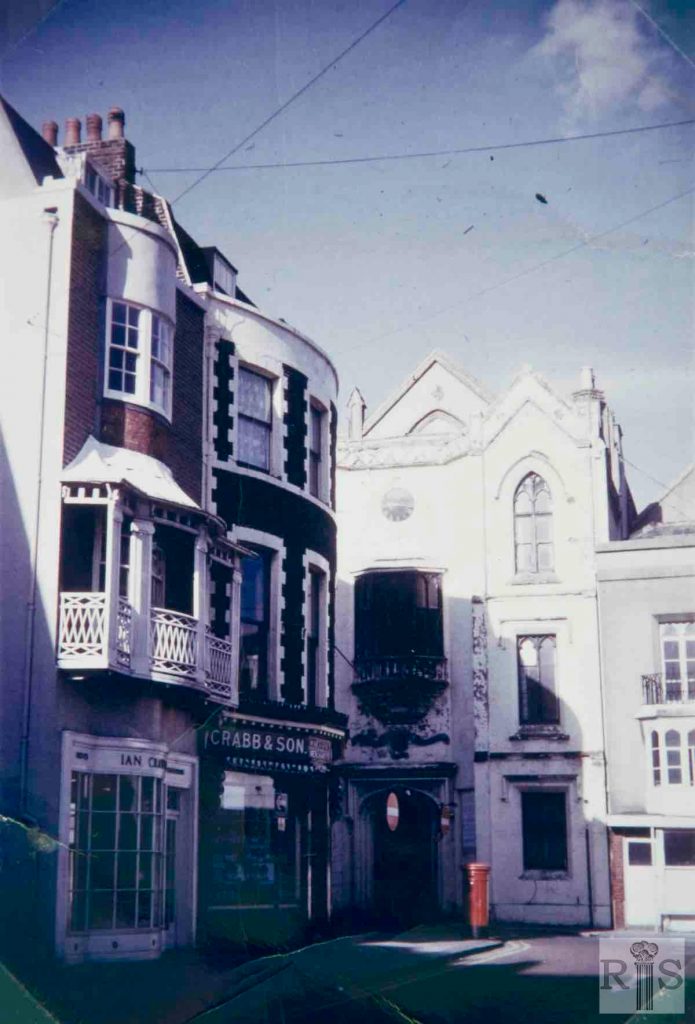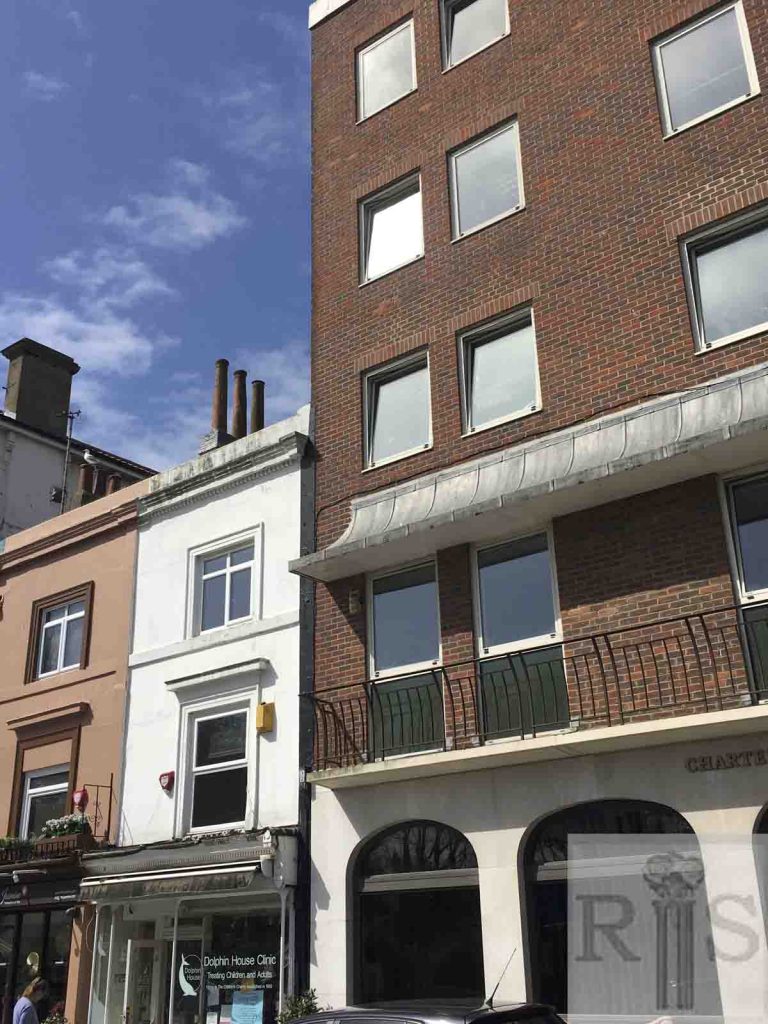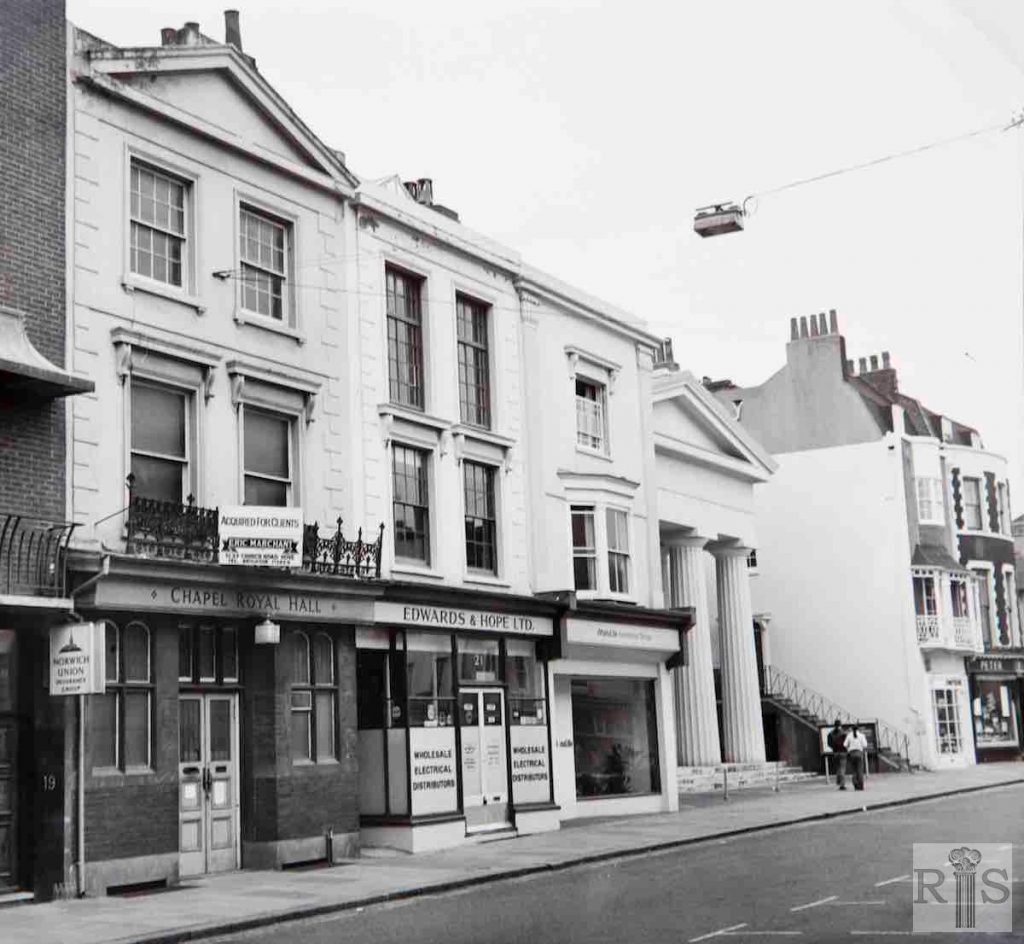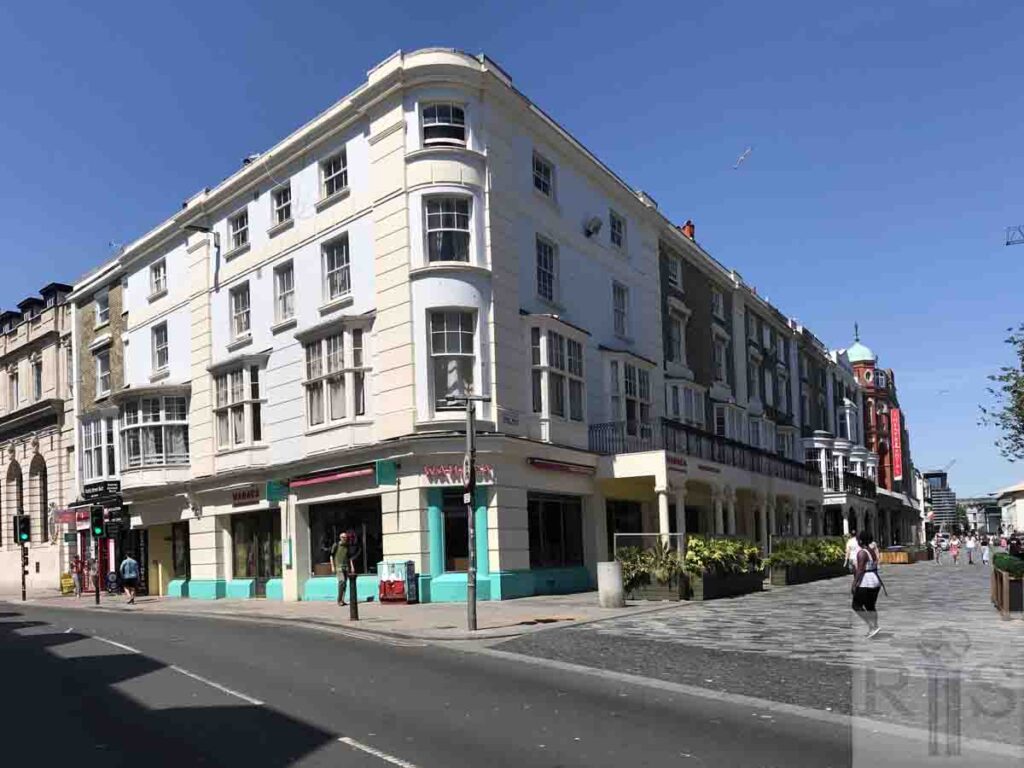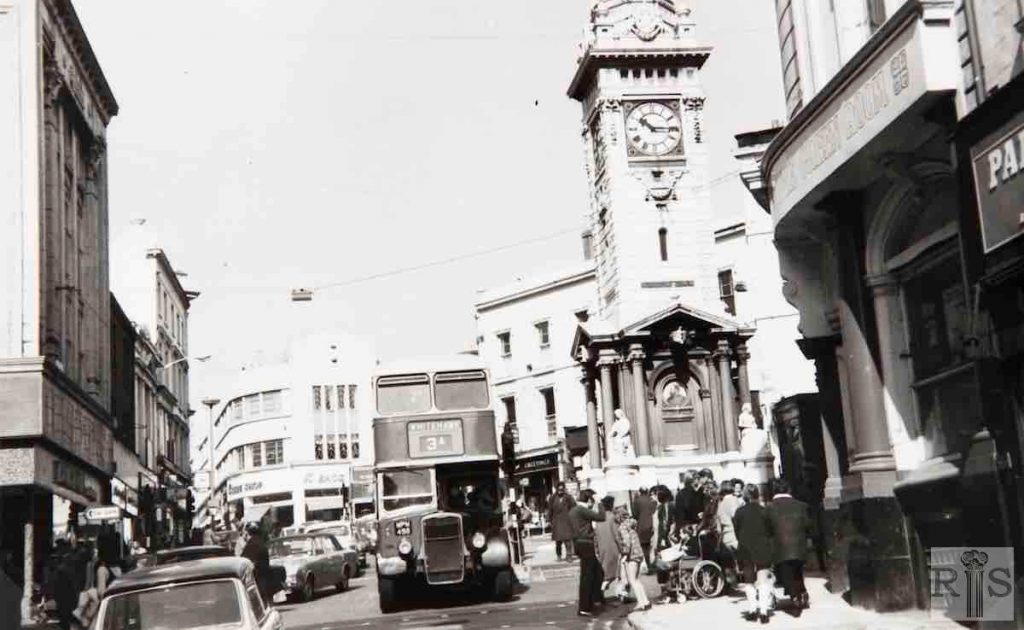
James Gray: This page and the succeeding [images jgc_25_044 and 045] are photographs of Dome Cottage, New Road. This was originally the coachman’s cottage, which adjoined the Prince Regent’s private stables in the Royal Pavilion grounds. At a later period the courtyard was used for storage of Fire Engines while the Inspector lived in the cottage. For 40 years prior to its demolition in 1934 it had been occupied by the works supervisor of the Pavilion Estate. After its removal the Pavilion Theatre was erected on the site. jgc_25_043
2018: The Pavilion Theatre (now known as the Brighton Dome Studio Theatre) was built in 1935 and was first used as a supper room for the Corn Exchange next door. Soon afterwards, it became a theatre and is currently undergoing a major refurbishment. It is Grade II listed, along with the box office next door, and will reopen in 2019. (Photographer: Denise Taylor)
James Gray: These two photographs [jgc_25_046 and 047] provide excellent views of the colonnade as it was in 1895, before any part of it had been removed. The horse bus seen in this photograph was one of Tilley’s buses which plied from New Road to just beyond the Arch in Lewes Road, by the cemeteries. The railings of the Pavilion grounds were removed in March 1937. jgc_25_046
James Gray: A view of the shops in the colonnade in New Road. jgc_25_047
2018: A G Avenell & Son was a tailoring business specialising in court, naval and military tailoring. It was located at 4, 5 and 6 New Road. No 4 has had the bow window above the colonnade changed to a bay, No 5 has lost the colonnade entirely, and No 6 retains the full bow window above. (Photographer: Denise Taylor)
James Gray: This is an interesting photograph as it shows the complete unbroken New Road frontage of the Colonnade. As to its date I would think it was midway between the others showing the theatre. Certainly it is after 1871 as the rebuilt Countess of Huntingdon’s Church is seen at the end of the road. jgc_25_050
James Gray: View of the north end of this road showing the Central National School in 1971, the year in which it was demolished. jgc_25_051
2018: The two buildings on the corner of New Road and Church Street have changed very little apart from the businesses that occupy them: the first is now Mister Smith Interiors and the cobble-fronted corner property is now Caffe Italiano. The Crabb & Son wine merchants in the original image occupied the corner site from around 1890 till the 1980s. The new building opposite New Road houses a Carluccio’s restaurant with offices above. (Photographer: J C Reid)
James Gray: Theatre Royal. jgc_25_052
James Gray: The New Road frontage as it was in November 1883. This is the only photograph I have seen of the Theatre prior to its reconstruction and redecoration in 1894. jgc_25_048
2018: Beneath the scaffolding, the theatre has changed very little since its 1894 remodelling. (Photographer: J C Reid)
James Gray: The Paris Cinema. It was opened in 1854 as the New Oxford Music Hall and then became the Empire Theatre of Varieties. By the first decade of this century it was the Court Cinema and this lasted for nearly 40 years. In the 1940s it reverted to the stage, being successfully the Dolphin and Her Majesty’s Theatres. Finally, a few years as the Paris Cinema before oblivion. This photograph, dated 2 March 1963, was taken just before the building was sold for subsequent demolition. jgc_25_053
2018: The building was demolished in 1967 and replaced by a rather dull office block. (Photographer: Denise Taylor)
James Gray: The Cinema finally closed on May 2nd 1963. It had been sold to the Norwich Union Insurance Company and remained in existence, empty and dilapidated, for some little time afterwards before demolition and the building of replacement offices on the site. The old name COLISEUM had been brought to light on the high side wall. jgc_25_054
2018: A recent office building, Pavilion View at 19 New Road, now stands on the former site of the Paris Cinema. The two buildings to the left of the office block have changed very little apart from the window panes and window boxes. (Photographer: J C Reid)
James Gray: The final days. Photographs taken in July 1963, after the closure. The rather drab exterior gave no clues to the splendour of the interior, with its gilt plaster of ceiling and boxes, dark red plush seat covering and box rails and glass chandeliers in the ceiling. The interior is one of a series of views I have taken at this time. jgc_25_055
James Gray: More photographs [jgc_25_056, 057 and 058] of the Paris Cinema in 1963, closed and awaiting demolition. The drab exterior gave no clue to the glory of its magnificence inside. In this photograph the building immediately to the right of the cinema was the Chapel Royal Hall demolished in 1986. jgc_25_057
James Gray: [See caption for jgc_025_057 above.] jgc_25_058
2018: A large office block (Pavilion View, 19 New Road) now stands on the site of the Paris Cinema. The Dome Café to the left (south) of the cinema in the 1963 photograph is now the Dolphin House Clinic, while the building on the right is now the Polpo restaurant. (Photographer: Lyn Turpin)
James Gray: On the east side of New Road is No. 28, seen here when occupied by Charles Hughes, described in the Brighton Directory of 1877 as ‘Lithographic & copperplate printer and stamper’. He was there from the early 1870s until the 1890s. In its private house days the building may have had a canopy, see the marks on the first floor wall. The year of the photograph is unknown. jgc_25_059
2018: New Road was created on the site of Furner’s Garden in 1805 in exchange for allowing the Prince of Wales, who bought the site in 1804, to close off the section of East Street that ran from North Street to Church Street, to give more privacy to the west of his seaside residence. Leaders Estate Agent currently occupies No 28. The windows and entrance of the building are much altered. (Photographer: Denise Taylor)
James Gray: The Chapel Royal Hall, in New Road, photographed on 10 July 1977, when its destruction was thought to be imminent. Built as a pair with the adjoining property, in the early years of New Road. For very many years the two buildings were occupied by the firm of T Crunden, Furniture Brokers, and it was only during the present century that it became associated with the Chapel Royal. Often used as an Auction Room, the building lingered on until 1986 when it was demolished. A shop and offices above are to be built here. jgc_25_123
James Gray: A photograph showing the full extent of the Colonnade from 157, North Street round to and beyond the Theatre Royal. Period about 1910. jgc_21_088
2020: The Colonnade now only extends along the southern end of New Road. The North Street part of the Colonnade was removed in the 1920s, the last section in 1929 as part of the North Street widening scheme. (Photographer: Mike Doodson)
James Gray: This old photograph, dating from 1871, the time of the rebuilding of Countess of Huntingdon’s Church, gives just a glimpse of the Colonnade as it rounds the corner of New Road into North Street. jgc_21_122
2020: Huntingdon House (with Watches of Switzerland at pavement level) now graces the site of the Countess of Huntingdon’s Church. A colonnade remains at the corner of New Road and North Street. (Photographer: Mike Doodson)
James Gray: The view along New Road, showing the Colonnade extending from opposite the second house to the Theatre Royal and beyond. It was removed from in front of 2, 3 and 4 New Road in 1931 and is still unchanged now, 25 years later. Additional Information: Partially restored, early 2000s. jgc_21_123
2020: No comment. (Photographer: Mike Doodson)
James Gray: The Countess of Huntingdon’s Church. The rebuilt chapel was opened on 20 March 1871 and it seems likely that [this photograph was] taken soon afterwards in that year. jgc_21_135
James Gray: Compare this photograph with [jgc_21_135]. They were taken from about the same spot in New Road. 100 years of Brighton’s breezes have taken their toll. The final service was held on Sunday 25 September 1966, after which the church was closed. It still stands, 1968, but is likely to be sold and demolished. Photographed November 27th. 1966. jgc_21_136
James Gray: Countess of Huntingdon’s Church. New, 1895. jgc_21_130
James Gray: Plaque on the front of the church. It reads: “George Whitefield, Fletcher of Madely, Augustus Toplady, William Romaine, and other leaders of the great Evangelical revival preached on this spot. The present building was erected during the ministry of the Rev. J B Figgis M. A. 1861 – 1897″. jgc_21_137 THIS DOES NOT MATCH THE IMAGE CURRENTLY ON THE PAGE










